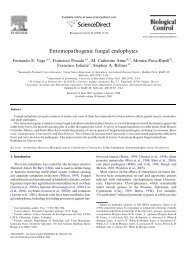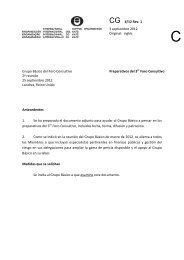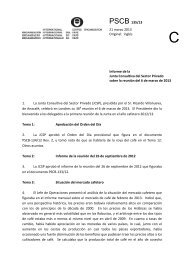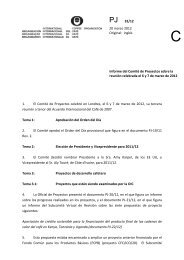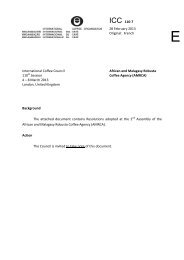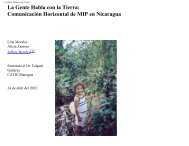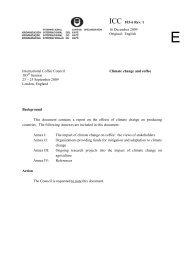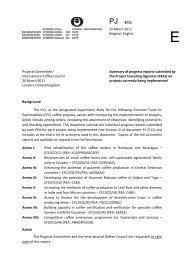Devouring profit - International Coffee Organization
Devouring profit - International Coffee Organization
Devouring profit - International Coffee Organization
You also want an ePaper? Increase the reach of your titles
YUMPU automatically turns print PDFs into web optimized ePapers that Google loves.
Colombia: “Authorities from the police and army confirmed that in the last<br />
three years, as the coffee sector crisis deepened, the Departments of Caldas, Tolima,<br />
Risaralda, Quindío and N Valle suffered a severe fracturing of public order. Robberies rose<br />
by 90% in the last 3 years, kidnappings shot up and the insecurity on the highways<br />
became generalised.” [El Tiempo, Colombia, December 2001]<br />
<strong>Coffee</strong> is globally significant for development. As the most valuable product of the<br />
tropics, for more than a century it has been a principal product of national economies<br />
in many developing countries. Some rough calculations estimate that about 22 million<br />
families live from coffee. Additionally, the coffee industry as a whole generates about<br />
100 million jobs with 60% of them in the producer countries (Federación Nacional de<br />
Cafeteros, 2001).<br />
The coffee berry borer (CBB) is the most important coffee pest because of its worldwide<br />
distribution (present now in all coffee-producing countries except Hawaii, Papua<br />
New Guinea and Panama) and its cryptic lifestyle (Le Pelley, 1968). Hidden inside the<br />
bean for most of its life, it causes direct loss of value to the product and is hard to<br />
control by pesticide applications.<br />
A problem such as CBB throws into high relief many of the issues caused by the<br />
rapidly changing and globalising coffee industry. These include: the quest for higher<br />
quality, health and environmental concerns about pesticide abuse, the applicability of<br />
developed country concepts to solve developing country problems, the declining fortunes<br />
of research/extension services and the difficulties of providing the rural poor<br />
with new knowledge and techniques.<br />
To understand the issues, we will first resume some relevant knowledge about CBB<br />
and how it is presently controlled. We will then examine the problem in specific<br />
countries from several sources including data collected through interaction with poor<br />
smallholder farmers. From this we develop both an economic analysis of CBB and<br />
then generate some hypotheses about the underlying forces involved. We end by<br />
making recommendations to improve CBB control in the future.<br />
1.1 The berry<br />
borer problem<br />
The female CBB perforates the berry and penetrates into the developing coffee bean.<br />
She then starts to feed from the bean and the reproductive cycle commences, causing<br />
very significant losses (Decazy, 1990). The degree of damage is complex to define<br />
because the pest can cause at least three types of loss: premature drop of younger<br />
berries, loss in weight and loss in quality (see Chapter 4).<br />
CBB live almost exclusively in coffee berries. There are a few records of them attacking<br />
other seeds, but alternative hosts are insignificant. Each female (2 mm long) will lay<br />
30 or more eggs that take four to six weeks to mature to new adults. Siblings incestu-<br />
13




